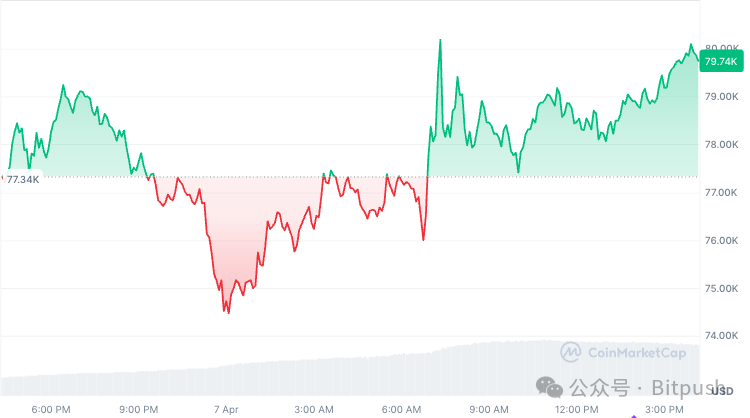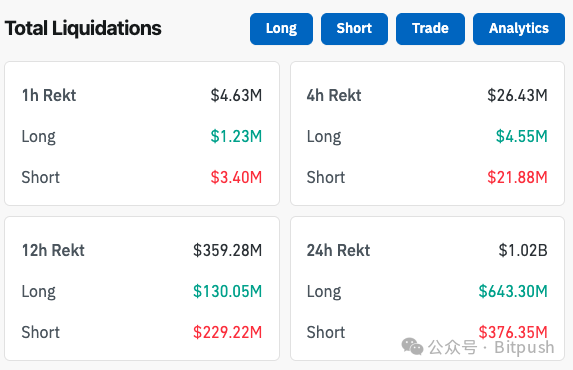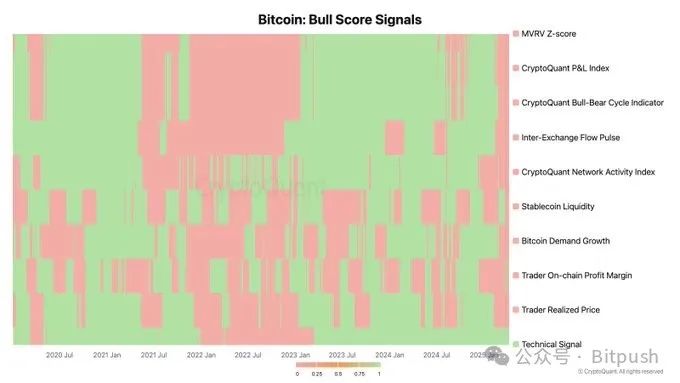Written by: BitpushNews Mary Liu
Over the past 24 hours, market trends have fluctuated dramatically with news, as details of Trump's tariff policy swung from "90-day postponement" rumors to "debunked fake news" - Bitcoin experienced intense volatility within 24 hours, dropping to a low of $74,436 before rapidly rebounding to $81,200, with an intraday amplitude reaching 9%.
At the time of writing, Bitcoin is holding the critical support level of $79,000, Ethereum struggled to recover after breaking below $1,500, and XRP is trading at $1.92.

The derivatives market shows heavy risk aversion, with total open interest suddenly dropping 10% to $91.19 billion. Coinglass data shows liquidations exceeding $1 billion in the past 24 hours, with Bitcoin's market cap share slightly increasing to 62.6%.

Expert Opinions: What's Next?
CryptoQuant Research Director Julio Moreno believes:
"Currently, buy the dips is like catching a falling knife! Bitcoin's situation has not improved. Only one bullish signal exists in the bull market scoring index."

Pantera Capital Partner Cosmo Jiang told Bloomberg:
"Current market trends are primarily driven by macro factors. This tariff-induced pullback is an event-driven decline, not caused by deep economic issues. Just as tariff policies are artificially introduced variables, the Trump administration can withdraw these measures when they believe they've obtained sufficient concessions from other countries."
Binance Research's latest report suggests that ongoing geopolitical and economic uncertainty may continue to dominate the market:
"The most aggressive tariffs since the 1930s are creating chain reactions in macroeconomic and cryptocurrency markets. In the short term, cryptocurrencies may continue to fluctuate, with market sentiment shifting as trade wars develop. If macro conditions stabilize, new narratives take hold, or cryptocurrencies re-establish their role as long-term hedging tools, new growth may follow. Until then, the market may remain range-bound and responsive to macro news."
Stephen Wundke, Strategy and Revenue Director at quantitative digital asset investment firm Algoz, stated:
"At present, the market hates uncertainty, so we can expect trading to be more volatile in the coming weeks/months, and the next rally will be delayed (anyway, just [quoted]) - unless Trump makes another powerful statement about the crypto industry. The only thing we can be certain of is that the current White House messages lack any certainty."
Charlie Sherry, Financial Director and Cryptocurrency Analyst at BTC Markets, noted in his market update:
"Bitcoin recently lost the key support level of $79,000 to $80,000 that it successfully maintained over the past month. This support level marks the bottom of the range after the historical high pullback. The next key support is around $72,000, which was the highest point before the US election. A potential shift in Trump's stance or an emergency intervention by the Federal Reserve are two factors that could help Bitcoin's price recover above $80,000."
Bitcoin researcher Axel Adler Jr. pointed out:
Short-term forecasts show Bitcoin price will oscillate between $81,600 and $87,700, with the critical "maximum pain point" of $86,000 serving as an important benchmark for the April 11th options expiration. In the medium term, if macroeconomic uncertainty persists and Fed rate cut expectations rise, some traditional market funds might shift to Bitcoin for support. However, investors should be cautious of the risk of sharp pullbacks due to overall risk-averse tendencies.
Greg di Prisco, co-founder of centralized stablecoin development company M^0 Labs, commented on the Trump administration's long-term impact on cryptocurrencies:
Perhaps more important than Trump's direct actions is his influence on the legislative process, which is the most significant development for the industry. Stablecoin bills being considered by state governments will position the US advantageously in competition.
Prisco shared his top three predictions for the crypto industry in 2025:
1. I believe you'll see the GENIUS bill become the legislation the government ultimately agrees on and passes, likely in the second half of the year. 2. More traditional financial institutions will begin launching tokenized products inspired by BlackRock's BUIDL success. 3. Stablecoins will continue to prove themselves as the killer use case for cryptocurrencies, beginning to integrate into mainstream fintech applications.






